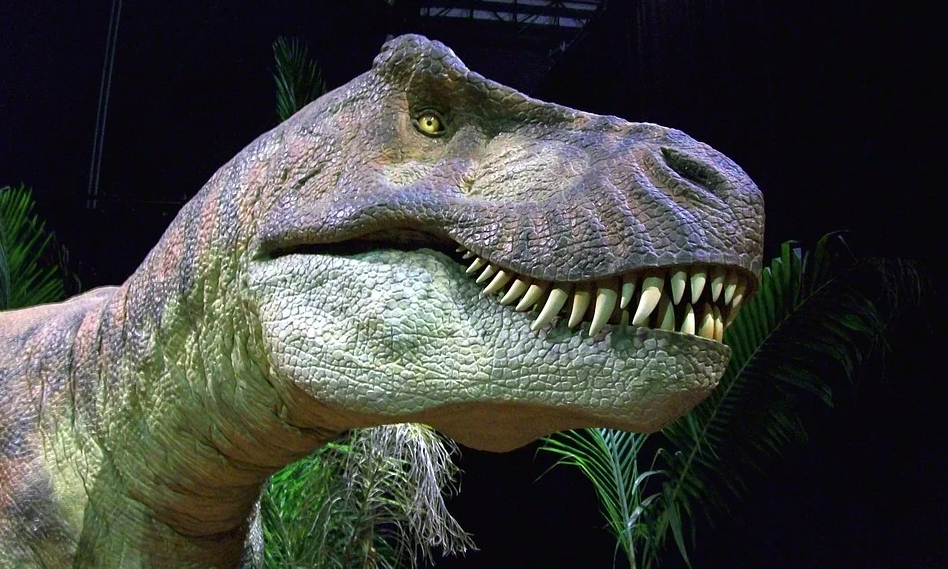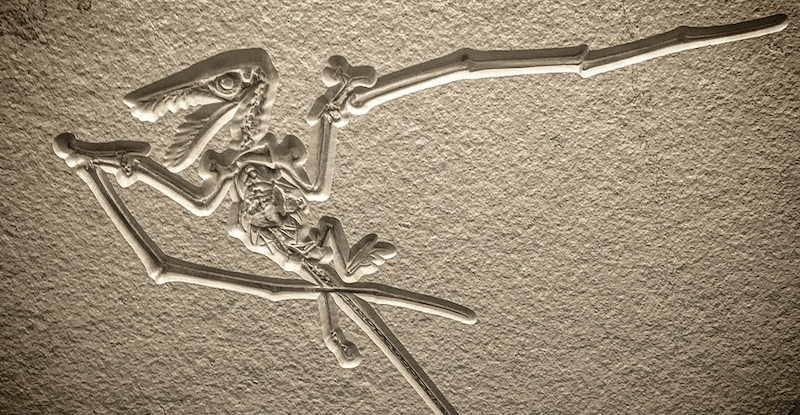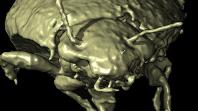- All fossils of the dinosaur Tyrannosaurus have been attributed to a single species: the famed T. rex.
- New analyses based on a dataset of fossils led a group of researchers to question whether T. rex is one species. They suggest two additional species should join it.
- Other paleontologists say the evidence is too weak to split apart the emblematic T. rex. The debate illustrates the difficulties of identifying and naming species.
Known for its immense size, predatory prowess, large teeth, and tiny limbs, Tyrannosaurus rex has long been the poster child of dinosaurs. The fame of T. rex extends beyond paleontological circles, with movies like Steven Spielberg’s Jurassic Park catapulting the dinosaur into broader cultural consciousness.
The first T. rex skeleton came to light in 1902 in Montana’s Hell Creek Formation, where the dinosaur was thought to have spent the last million years of its reign. Before 1980, everything we knew about T. rex was based on four incomplete skeletons. In the decades since, more than two dozen other specimens of T. rex have turned up. When uncovering new fossils, scientists noted variation within these specimens. They split the specimens into two types: a robust morph with large, broad bones, and a slender, gracile morph. Researchers initially hypothesized that differences in the sex and age of the dinosaurs explained the variations.
T. rex: one species or three?
Gregory Paul, an independent and prolific paleontologist, thought there might be another explanation. Perhaps these different forms of T. rex are not T. rex at all, but other species in the genus Tyrannosaurus. With the surge of fossil discoveries, Paul finally felt he had the data he needed to put this idea to the test. After assessing three dozen Tyrannosaurus specimens, Paul and his team of researchers argued that the fossils cluster into three distinct species.
To name any species, researchers follow an international convention. Species names are split into two words. The first indicates the genus name, and the second lists the specific name, or epithet. Together, the words make up a unique species name. Now, along with T. rex (Latin for the “king” Tyrannosaurus), Paul and colleagues proposed the inclusion of T. imperator (“emperor”) and T. regina (“queen”). Their results, published in the journal Evolutionary Biology, sparked intense debate among paleontologists.
Not all T. Rex are created equal
Robustness is not the only line of variation. Tyrannosaurus specimens also exhibit differences in their teeth. Some possess a single incisiform tooth, while others have two. Paul and his colleagues contend that since these variations progress within the genus over geological time, the differences could hint at evolution at the species level.
Evidence of physical differences is certainly not proof enough of speciation. Evolution takes course over millions of years. This means that a species must endure for a long time to branch off into other species. Additionally, there must be an ecological reason to instigate speciation.
Paul and his colleagues argue that T. rex had both the time and the ecological pressure that speciation requires. First, the time over which Tyrannosaurus existed — 2 to 2.5 million years — meets the necessary threshold. Second, T. rex was most active during the Mesozoic era, when many species of dinosaurs existed within the genus. If similar types of dinosaurs split into species, there were likely enough ecological niches available for the same speciation events to occur in Tyrannosaurus.
Gathering evidence of exceptional variation
The conditions for speciation seem appropriate. Still, Paul and his colleagues needed to show that the variation between Tyrannosaurus morphs is exceptional. The differences between morphs should exceed the degree of physical variation exhibited within other species (variations that occur perhaps due to age, or between sexes). If they do, the evidence would indicate that we are looking at multiple species. The researchers also hoped to show definitive links between the distinct Tyrannosaurus morphs. Having an extra incisiform tooth should correspond with either the robust or gracile morph.
The researchers made specific predictions they hoped to test. For example, if these morphs are just different sexes of T. rex, the numbers of each form should be roughly equal. If the morphs correspond to age, they should be seen together across the extent of the T. rex fossil record, though not necessarily in equal numbers. However, if the two forms are separate species, we should see a progressive shift in the predominance of one form over the other.
Paul and his colleagues took to museum collections to gather their evidence with these thoughts in mind.
Looking for clues
The researchers collected and analyzed a suite of anatomical measurements on 38 different Tyrannosaurus specimens. They focused on femoral proportions — the ratio of the bone’s length to its circumference — as the primary assessment of specimen robustness. This proportion is important because the femur supports the entire body mass of the dinosaur. They also assessed the teeth of each specimen to track whether the number of incisiform teeth correlated with robustness.
To test whether the variation seen in femoral measurements exceeds what we expect of a large-bodied species, they collected data on four related genera, including Albertosaurus. They plotted the variation and fit an equation to each species. This let the researchers create a model that would tell them whether Tyrannosaurus femoral variation falls inside or outside what we might expect. The researchers then charted the morphs on both a spatial and temporal map to see whether they regularly occur in the same place at the same time, as a single-species hypothesis would predict.
Results point to multiple species, maybe
The researchers found unusual variation in femoral proportions among the specimens. When compared to other species, variation exceeds the expectation by around 14 percent. After removing the smallest specimens, Tyrannosaurus variation is nearly 55 percent more than expected. Finally, robust Tyrannosaurus outnumber gracile Tyrannosaurus more than two to one. We would not expect that pattern if robustness were related to sex. This ratio also challenges the hypothesis that robustness is related to age. Since robust forms should be the relatively uncommon byproduct of a few individuals making it to old age, we would expect to find fewer, not more, robust dinosaurs. Finally, the researchers found that the gracile morphs more often had a single incisiform tooth.
The Tyrannosaurus fossils were also found in three distinct sediment layers. The depth of each layer corresponds to a time period. The oldest fossils appear in the lower layer, and the youngest in the upper layer. Interestingly, they found that the three morphs did not overlap in all three layers. These findings suggest that as time went on, the physiology of Tyrannosaurus changed. They also indicate that the different morphs were probably not different ages or sexes of the same species.
In the end, the data collected did not meet the standards to formally accept a hypothesis for Tyrannosaurus variation. However, the authors retain that the most likely explanation is the morphs are multiple species of Tyrannosaurus. Under this explanation, there are three types. These are Tyrannosaurus imperator, a robust form with two incisiform teeth; Tyrannosaurus rex, a robust form with one incisor; and Tyrannosaurus regina, a slender form with one incisor.
Not all paleontologists are convinced
The authors end their paper with a question. They wonder “whether the three morphotypes should be merely noted and otherwise not formally recognized, or if separation at the species level is advisable.” Paul believes the data is sufficient. According to the researchers’ classification, only a few instances of the fossils are definitively T. rex. Without accounting for other species, the rest of the specimens are left “taxonomically hanging.”
Other paleontologists reject Paul’s hypothesis. Tyrannosaurus expert Thomas Carr of Carthage College argues that there is no substantial evidence to back it up. ”It’s just shades of gray and shapes in clouds,” Carr told National Geographic.
Carr was not the only paleontologist who calls the findings too vague to prove speciation. But Paul and his co-authors expected resistance. They note that criticism might not be so fierce if the object of the study were any dinosaur aside from the emblematic T. rex.
What is a species?
The debate echoes a long-standing ecological and biological problem: the species concept. Anyone who has taken advanced biology knows that no universal conditions clearly define a species. Some of the most well-known criteria, such as DNA similarity and the ability to have viable offspring, are useless in describing species that went extinct millions of years ago. The process is even trickier when we rely on fossils, which require very specific conditions to be preserved. A new discovery could happen at ay moment and rewrite the story of Tyrannosaurus.
Considering these challenges, the goal of the paper was not simply to propose that T. rex is more than one species, but to serve as “a means for framing and focusing future inquiry into the multiple species question.”
So, T. regina and T. imperator probably will not become quite as celebrated as their relative T. rex. But whether the species ultimately pass rigor is beside the point. Even if most paleontologists disagree with the findings, Paul’s paper is an example of how science often moves forward: by promoting a controversial idea that may not gain full acceptance but can spark a productive debate. This helps scientists revisit longstanding theories and data.






